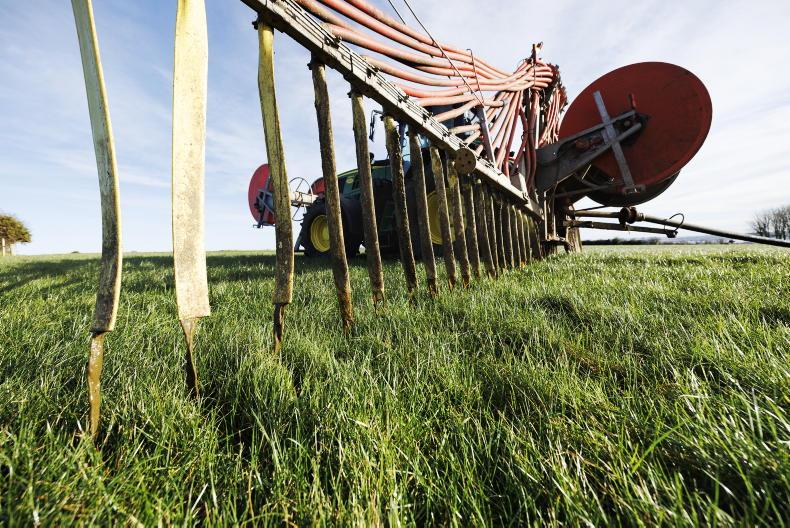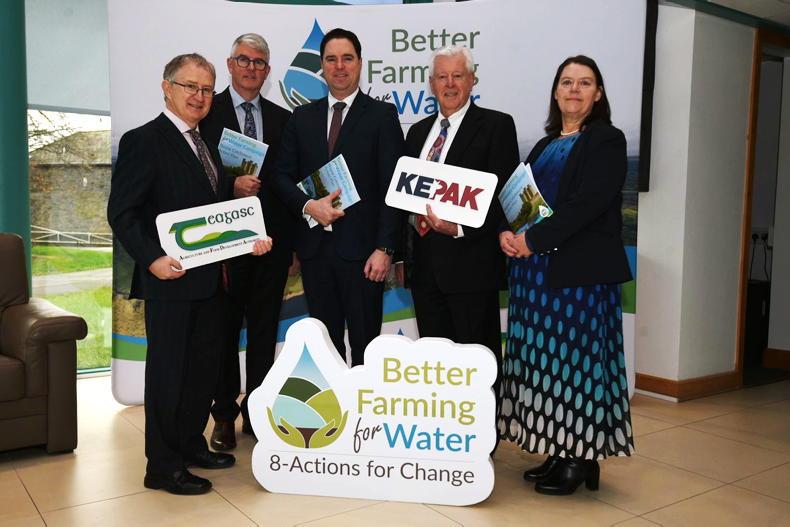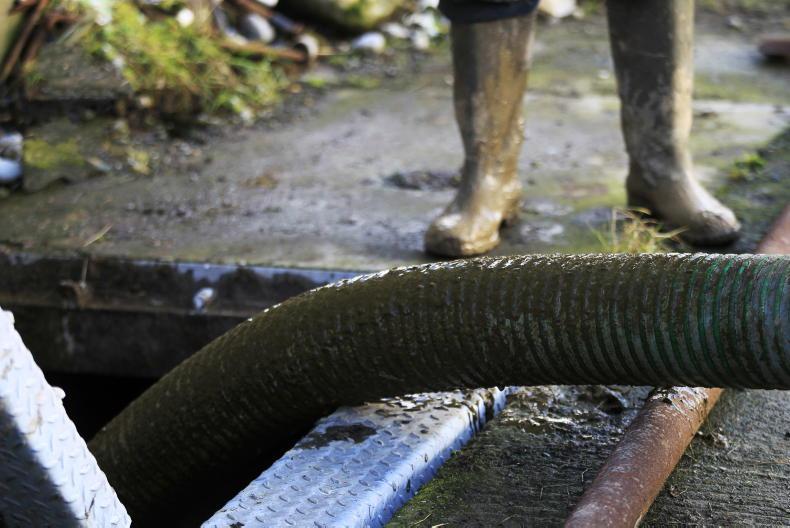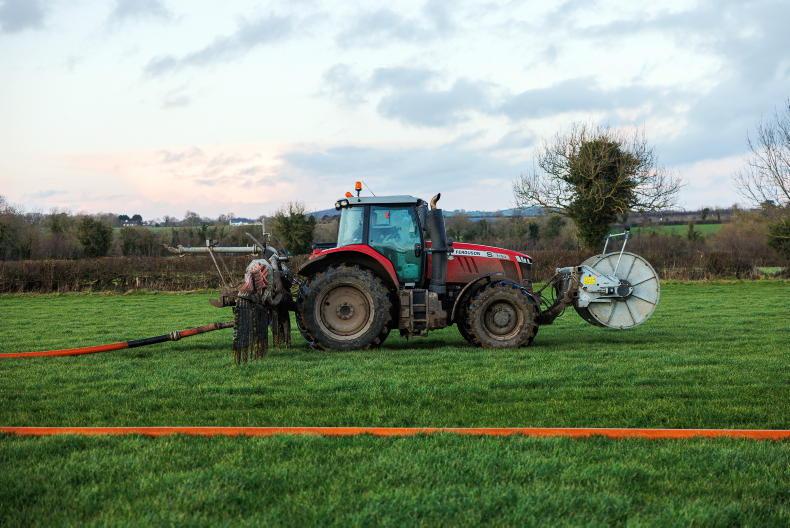Farmers operating outside of a nitrates derogation can be forgiven for thinking that discussions that include the term nitrates do not affect them. The nitrates derogation is one facet of Ireland’s nitrates action programme.
The nitrates regulations set the standard maximum stocking rate limit of 170kg/ha organic nitrogen, while the nitrates derogation allows farmers to operate at a higher stocking rate limit of 250kg/ha organic nitrogen.
The good agricultural practice regulations intertwine with the nitrates action programme and there are several requirements or regulations that all farmers should be cognisant of in 2023. Some of these are summarised below with more specific requirements for dairying and tillage.
LESS requirements
Farmers operating at a stocking rate of 170kg organic nitrogen, prior to the export of organic fertilisers, have already been abiding by a rule requiring them to apply 100% of their slurry using low emission slurry spreading (LESS) equipment.
This requirement is being expanded in 2023 as follows:
From 1 January 2023, compulsory usage of LESS will be introduced for all farmers operating above 150kg livestock N/ha. Pig farmers are also required to use LESS equipment from 2023 onwards while all organic manures applied to arable lands must be applied by LESS equipment or incorporated within 24 hours of application. From 1 January 2024, compulsory usage of LESS will be introduced for all farmers operating above 130kg livestock N/ha.From 1 January 2025, compulsory usage of LESS will be introduced for all farmers operating above 100kg livestock N/ha.For anyone considering purchasing LESS equipment through the Targeted Agricultural Modernisation Scheme (TAMS III), it is important to note that there is only a short timeframe to avail of grant aid when it becomes mandatory to apply slurry using LESS equipment.
All holdings operating below 170kg/ha organic nitrogen continue to be eligible for TAMS III LESS in 2023.
From 1 January 2024, applicants farming above 150kg/ha organic nitrogen are ineligible to apply for LESS equipment. This extends to those farming above 130kg organic N from 1 January 2025 and above 100kg organic N by 1 January 2026.
Soil sampling
There is a similar situation with soil sampling requirements. Prior to 2023, farmers operating above a grassland stocking rate of 170kg/ha organic nitrogen were required to carry out soil sampling to determine what nutrients could be applied.
From 1 January 2023, all farmers with a grassland stocking rate above 130kg N/ha must take soil samples. The rules also extend to tillage farmers who must also have up-to-date soil samples from the last three years.
The Department states that this will allow farmers and their advisers to tailor fertiliser plans to match the needs of the growing crop and soil they are grown in.
Where up-to-date soil analysis is not available then a phosphorus (P) index of 4 must be assumed which will have implications on the volume of P fertiliser that can be applied with chemical phosphorus not permitted in almost all cases.
This new requirement could catch farmers unaware in 2023 and, as such, it is important to be mindful of the type of fertiliser you are applying.
Slurry and
fertiliser
deadlines
The deadline for spreading slurry is being brought further forward in 2023 with the closed period for applying slurry starting on 1 October 2023.
This compares to 8 October in 2022 and farmers should note that the final day for applying slurry is 30 September, not 1 October.

An increasing number of farmers will be required to spread slurry using low emissions slurry spreading equipment. \ Donal O'Leary
The closed period for spreading fertiliser begins on 15 September in all zones, ie the last day for applying chemical fertiliser is 14 September. There is no change to the closed period for the application of farmyard manure which can be applied up to 30 October (closed period starts on 1 November).
There is a mechanism in place that can allow an extension of slurry or chemical fertiliser applications beyond the closing dates in exceptional circumstances.
This decision will be based on predefined scientific criteria with a low probability of an extension being granted.
Rules concerning the fencing of watercourses and diversion of runoff from farm roadways away from watercourses came into effect on 1 January 2021.
As such, many farmers have already addressed concerns but it is worth reviewing if there are any outstanding issues.
With regard to roadways, all farmers must ensure that direct runoff from farm roadways is diverted away from waters since 1 January 2021.
This includes watercourses, rivers, streams, drains, etc. For many farms and, in particular, dairy farms it has meant carrying out remedial works on roads to change the camber or fall to ensure runoff is diverted away from watercourses.
Rules
The rules pertaining to fencing require that farms with a grassland stocking rate equalling or exceeding 170kg/ha organic nitrogen must erect a fence at least 1.5m from the top of the bank of certain waters discontinuing access from grazing bovines to watercourses for drinking purposes.
The waters concerned here are those identified on the 1:5000 scale OSI map.
It is still be permissible to move livestock where necessary across a watercourse on occasion to an isolated parcel of land, provided that is that both sides of the watercourse are fenced and once animals cross the watercourse they are prevented drinking access.
The stocking rate used is based on the previous year’s figures and prior to the export of organic manures.
Farmers operating outside of a nitrates derogation can be forgiven for thinking that discussions that include the term nitrates do not affect them. The nitrates derogation is one facet of Ireland’s nitrates action programme.
The nitrates regulations set the standard maximum stocking rate limit of 170kg/ha organic nitrogen, while the nitrates derogation allows farmers to operate at a higher stocking rate limit of 250kg/ha organic nitrogen.
The good agricultural practice regulations intertwine with the nitrates action programme and there are several requirements or regulations that all farmers should be cognisant of in 2023. Some of these are summarised below with more specific requirements for dairying and tillage.
LESS requirements
Farmers operating at a stocking rate of 170kg organic nitrogen, prior to the export of organic fertilisers, have already been abiding by a rule requiring them to apply 100% of their slurry using low emission slurry spreading (LESS) equipment.
This requirement is being expanded in 2023 as follows:
From 1 January 2023, compulsory usage of LESS will be introduced for all farmers operating above 150kg livestock N/ha. Pig farmers are also required to use LESS equipment from 2023 onwards while all organic manures applied to arable lands must be applied by LESS equipment or incorporated within 24 hours of application. From 1 January 2024, compulsory usage of LESS will be introduced for all farmers operating above 130kg livestock N/ha.From 1 January 2025, compulsory usage of LESS will be introduced for all farmers operating above 100kg livestock N/ha.For anyone considering purchasing LESS equipment through the Targeted Agricultural Modernisation Scheme (TAMS III), it is important to note that there is only a short timeframe to avail of grant aid when it becomes mandatory to apply slurry using LESS equipment.
All holdings operating below 170kg/ha organic nitrogen continue to be eligible for TAMS III LESS in 2023.
From 1 January 2024, applicants farming above 150kg/ha organic nitrogen are ineligible to apply for LESS equipment. This extends to those farming above 130kg organic N from 1 January 2025 and above 100kg organic N by 1 January 2026.
Soil sampling
There is a similar situation with soil sampling requirements. Prior to 2023, farmers operating above a grassland stocking rate of 170kg/ha organic nitrogen were required to carry out soil sampling to determine what nutrients could be applied.
From 1 January 2023, all farmers with a grassland stocking rate above 130kg N/ha must take soil samples. The rules also extend to tillage farmers who must also have up-to-date soil samples from the last three years.
The Department states that this will allow farmers and their advisers to tailor fertiliser plans to match the needs of the growing crop and soil they are grown in.
Where up-to-date soil analysis is not available then a phosphorus (P) index of 4 must be assumed which will have implications on the volume of P fertiliser that can be applied with chemical phosphorus not permitted in almost all cases.
This new requirement could catch farmers unaware in 2023 and, as such, it is important to be mindful of the type of fertiliser you are applying.
Slurry and
fertiliser
deadlines
The deadline for spreading slurry is being brought further forward in 2023 with the closed period for applying slurry starting on 1 October 2023.
This compares to 8 October in 2022 and farmers should note that the final day for applying slurry is 30 September, not 1 October.

An increasing number of farmers will be required to spread slurry using low emissions slurry spreading equipment. \ Donal O'Leary
The closed period for spreading fertiliser begins on 15 September in all zones, ie the last day for applying chemical fertiliser is 14 September. There is no change to the closed period for the application of farmyard manure which can be applied up to 30 October (closed period starts on 1 November).
There is a mechanism in place that can allow an extension of slurry or chemical fertiliser applications beyond the closing dates in exceptional circumstances.
This decision will be based on predefined scientific criteria with a low probability of an extension being granted.
Rules concerning the fencing of watercourses and diversion of runoff from farm roadways away from watercourses came into effect on 1 January 2021.
As such, many farmers have already addressed concerns but it is worth reviewing if there are any outstanding issues.
With regard to roadways, all farmers must ensure that direct runoff from farm roadways is diverted away from waters since 1 January 2021.
This includes watercourses, rivers, streams, drains, etc. For many farms and, in particular, dairy farms it has meant carrying out remedial works on roads to change the camber or fall to ensure runoff is diverted away from watercourses.
Rules
The rules pertaining to fencing require that farms with a grassland stocking rate equalling or exceeding 170kg/ha organic nitrogen must erect a fence at least 1.5m from the top of the bank of certain waters discontinuing access from grazing bovines to watercourses for drinking purposes.
The waters concerned here are those identified on the 1:5000 scale OSI map.
It is still be permissible to move livestock where necessary across a watercourse on occasion to an isolated parcel of land, provided that is that both sides of the watercourse are fenced and once animals cross the watercourse they are prevented drinking access.
The stocking rate used is based on the previous year’s figures and prior to the export of organic manures.










SHARING OPTIONS